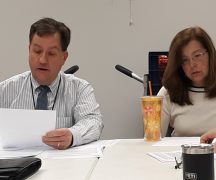By JAN LARSON McLAUGHLIN
BG Independent News
The state may need a refresher course on how to do testing.
Once again, Bowling Green City School District scored low in some areas on its state report card. But according to Superintendent Francis Scruci, that may say more about the tests than the school district.
In the area of “achievement” – which represents the number of students who passed the state tests and how well they performed on them – Bowling Green scored a D.
The sting from that grade is lessened a bit by the similar grades earned across the state, Scruci said. Of the 607 districts scored, only 22 got an A, 15 scored a B, 22 got a C, and 58 earned a D. The vast majority – 490 – earned an F.
“As educators we know when we create tests for classrooms, there should be a bell-shaped curve,” Scruci said. The fact that most districts failed, raises “obvious questions.”
“This is a pretty good illustration that this system is not working,” he said about the state grade cards.
Scruci is not alone in his harsh opinion of the state tests. Many Wood County superintendents share his criticisms.
“Everyone is frustrated with the system itself,” he said. “The system is flawed. If a teacher were to give a test and get scores like that,” they would do it again.
In addition to the “achievement” area, the other grades given to Bowling Green schools include:
- D for gap closing. This shows how well schools are meeting the performance expectations for the most vulnerable populations of students in English language arts, math and graduation.
- C for K-3 literacy. This looks at how successful the district is at getting struggling readers on track to proficiency in third grade and beyond.
- A for progress. This looks closely at the value-added growth that all students are making based on their past performances. Bowling Green scored A in all the areas of overall, gifted, students with disabilities and lowest 20 percent in achievement.
- A for graduation rate. This looks at the percent of students who are successfully finishing high school with a diploma in four for five years.
- C for prepared for success. Whether training in a technical field or preparing for work or college, this component looks at how well prepared the students are for future opportunities.
Scruci was particularly pleased with the value-added progress for the district.
“From a superintendent’s standpoint, that’s what we want to focus on. We’re seeing a lot of growth,” he said. “We’re never going to be content, but we’re certainly seeing growth.”
“We’re happy that pretty much across the board we’ve improved in every area,” Scruci said.
He noted the added efforts by teachers to make improvements, including many of them doing additional training in the summer.
“Our teachers are trying to make a difference,” Scruci said.
In a letter sent out to staff Friday morning, Scruci noted the “F” given to the district in the “indicators met” category.
“Please do not allow that to define you,” he told the teachers.
“As you can see there is a flawed system that has been created,” Scruci wrote in his letter to the staff. “Far from the bell-shaped curve that we as teachers were always taught to be an indicator of a ‘fair’ test.”
Scruci suggested that the staff take note of the positive progress the district made.
“Focus and be proud that under ‘Value Added’ we received all A’s and this is the area that I am most appreciative of the work you did,” Scruci wrote. “It is this area that reflects what we are supposed to be doing in education and that is helping students grow as learners. Be proud of what you have accomplished.”
Scruci added that there is more work to be done.
“Are we where we want to be as a district? No, but we are improving and making a difference in the lives of learners,” he wrote. “There is still work to be done but I am encouraged by the dedication and commitment that I see in you during the school year, summer, and out in the community. Thanks for all you do.”
Dr. Ann McCarty, executive director of teaching and learning for Bowling Green City Schools, reported to the board of education last month that the state had released preliminary reports cards for school districts.
The grades showed a more favorable report for Bowling Green schools. Some of the grades may still appear quite low to those outside education. But to educators, who know what the numbers mean, they showed great improvement, McCarty said.
For example, in the area of “gap closing” between special education and other students, the district improved from an “F” to a “D.”
“That’s huge in terms of statistics,” McCarty said. “Our teachers worked really hard on this.”
Other success stories were found in K-3 literacy, which went from an “F” to a “C.”
“This is a huge upgrade for us,” she said.
The elementary schools saw significant gains. “Our teachers were doing things differently,” McCarty said.
In the area of social studies, fourth graders met the state benchmark. And in English, “almost every single grade saw growth. We’re seeing growth out of our students.”
In the area of math, sixth and seventh grade math showed solid gains, and high school algebra scores rose 15 percent. “That’s a huge gain,” McCarty said.
All the second language students in third grade passed, which is quite an achievement, she added.
The only drop seen was in science, and McCarty said that was most likely due to new technology.
McCarty credited the teachers for trying different techniques to try to raise the report card scores. For example, third graders at Kenwood Elementary had a 37 percent pass rate when tested in November. When tested again in the spring, those same students showed a 67 percent pass rate.
The teachers used collaboration and curriculum programs to make improvements. In some cases, they kept going back to the drawing board till they came up with strategies that worked.
And the work didn’t stop when schools closed for the summer, with many staff participating in training over the summer.
“This speaks to the dedication of our staff,” she said, pointing to the lists of summer trainings and the improved grade cards. “This right here is why we’re seeing things like that.”





